Dieter Arnold.
Building in Egypt; Pharaonic Stone Masonry (New York and Oxford 1991)
CHAPTER VI
Tools and Their Application
(For educational purposes only. The file will be immediately removed
if the author or publisher will claim their disagreement with this publication)
MEASURING TOOLS
Cubit Rods вИЩ Richard Lepsius — after a few less important
predecessors — and Petrie were the first and last authors to study seriously
the Egyptian cubit rod.1
Lepsius collected information about fourteen more or less complete cubits.
Most of these examples were not actually used as tools, but as votives,
or were made for the funerary equipment and therefore made of hard stone.
Some, however, are of wood, the material actually used for cubit rods by
architects.
 |
|
Fig. 6.1 Modern replica of a wooden cubit rod in
the Metropolitan Museum of Art.
|
They resemble our yardsticks, being short (52.5 centimeters) and stout,
with a quadrangular section and a fifth side produced by chamfering the
front top edge (fig. 6.1). The front, the oblique, and the top faces were
used for marking and numbering the single measurements. The rear and undersurface
were often inscribed with the name of the owner. The measurements indicated
consist of the 7 palms and digits and their subdivisions. Their lengths
vary from 52.3 to 52.9 centimeters, reminding us that ancient measures
were not so standardized as those of today and that such discrepancies
have to be taken into account in our calculations of Egyptian buildings.
In the tomb of the architect Kha at Deir el-Medina,2
two cubits were found. One was gilded and inscribed—apparently not made
for daily use but as an honorary royal gift to the esteemed architect.
The other one of plain wood, could be folded in two parts by hinges and
was probably used by its owner for actual work.
Another, more unusual cubit rod of "white wood" in the British Museum3
is 2 cubits long (1.0489 meters or 2 x 0.52445) and shows that EgypвХЬtian
architects had longer tools as well. In the settlement of Lisht North were
found two primitive cubit rods made for daily use, one of them with marks
for half- and quarter-cubits.
Apparently, stonemasons also used another measuring unit, the nby-rod,
which might have been about 67 to 68 centimeters long, subdivided into
seven spaces. Unfortunately, there is not much evidence for its application
and exact dimension.4
Measuring Cords вИЩ For measuring great distances, ropes
were certainly used, the predecessors of modern measuring tapes.5
Since the number 100 is represented in hieroglyphs by a rope  ,
one might suggest that measuring ropes of 100 cubits (52.5 meters) were
used. Reisner once thought that the hieroglyph
,
one might suggest that measuring ropes of 100 cubits (52.5 meters) were
used. Reisner once thought that the hieroglyph  might represent a measuring
cord, taking the end loops as handles and the side loops as tags marking
the cubits.6 Such ropes are shown in statuary
of the Eighteenth Dynasty, held by kneeling officials who present their
tools to the god.7 These
ropes were adorned with the ram head of Amun. In about eleven representations
of the measuring of the wheat fields in Theban tombs,8
we see surveyors working with such ropes, which have knots, apparently
indicating subdivisions, probably cubits (fig. 6.2).
might represent a measuring
cord, taking the end loops as handles and the side loops as tags marking
the cubits.6 Such ropes are shown in statuary
of the Eighteenth Dynasty, held by kneeling officials who present their
tools to the god.7 These
ropes were adorned with the ram head of Amun. In about eleven representations
of the measuring of the wheat fields in Theban tombs,8
we see surveyors working with such ropes, which have knots, apparently
indicating subdivisions, probably cubits (fig. 6.2).
 |
|
Fig. 6.2 Surveying fields with ropes, as depicted
in the Theban tomb of Menna.
|
Dorner rightly suggests, however, that such ropes could have been used
for only rough measurements, such as for fields.9
A rope 52.5 meters long would have to be very thick, and the knots for
its subdivision would have been so bulky that it could not have been used
for accurate work. One might think, however, of different means of marking,
such as the loops suggested by Reisner, fixed at a spot marked with red
paint. By a practical test, Dorner also found that the length of a rope
could be influenced by humidity, so the measuring tapes had to be treated
with fat. Another interesting result of Dorner's calculations is that the
famous base length of the pyramid of Cheops could have been achieved most
accurately by using cubit rods 4 or 8 cubits long.
That ropes were actually used by builders is, however, shown by the
method of producing the red leveling lines on the walls of buildings. The
marks were made by dipping a cord into red ocher, stretching it over the
surface, and lightly flinging it against the surface. Such cords were of
course not necessarily measuring cords or ropes. A reel is preserved with
a thin cord still attached and wound around a rotating axle (fig. 6.3).10
 |
Fig. 6.3 A sculptor's cord on a reel
from a Middle Kingdom tomb at Deir el-Bahari.
(MMA acc. no 22.2.72) |
Plumbs вИЩ Plumbs consist of a plumb bob, suspended from
a peg or a stick, which could also be used to reel up the cord. Many plumb
bobs got lost during the actual work and have been recovered. They vary
in material, shape, and size. Petrie collected a great variety,11
with examples from the Third Dynasty on.
A more elaborate type of plumb was found in the tomb of the architect
Senedjem at Deir el-Medina (fig. 6.4).12
The board was held vertically against the wall to be tested, and the plumb
bob was attached to a wooden crossboard so that the cord, if in a vertical
position, would touch a second cross board below, which was the same size
as the first. Plumbs were also used to put a square level in position.
The string was fixed at the top of the two legs of the square, and the
tip of the plumb had to touch the center mark on the cross board.
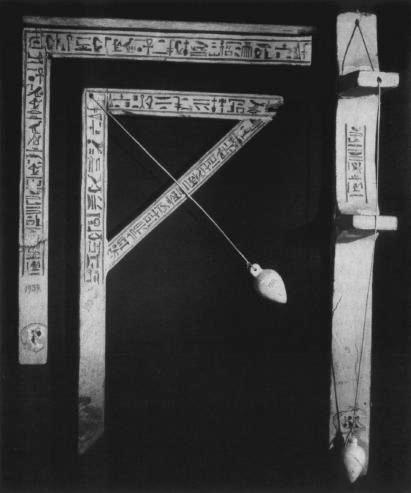 |
Fig. 6.4 A plumb, a square, and a
square level from the tomb of Senedjem
at Deir el-Medineh. (Cairo 27280, 27259, 27258) |
Builders' Squares вИЩ Egyptian builders and masons made
use of the simple wooden device, the square, in order to lay off or check
right angles, in building as well as dressing blocks. It is in principle
the same instrument that is used today. Few squares have actually been
found. The simplest version consists of two arms, connected at a right
angle with pegs or with tongue and groove.13
One of the two legs could be strengthened by a footboard, which allowed
the square to stand upright by itself (fig. 6.5).14
There may also have been squares with a third piece of wood connecting
the two legs in the shape of an A, similar to the square levels. In the
tomb of Rekhmira, a square is shown lying in a carpenter's workshop,15
reminding us that squares could be used by other craftsmen as well.
Square Levels вИЩ The square level not only was the
leveling instrument of Pharaonic Egypt, but was used in Roman and medieval
building as well. It was only later superseded by the water level, which
was known to the Romans but was used by them for only special purposes.16
The oldest Pharaonic plummet known dates only from the Middle KingвХЬdom.
One can be sure that it existed much earlier. Although the medieval building
square levels could have several shapes,17
the Egyptian specimens seem always to have had two legs of equal length,
connected at a right angle with a cross lath, so that the tool was in the
shape of the letter A. The legs were made in a way to make it stand. Near
the connecting corner of the two legs was suspended a plumb bob, which
could coincide—when the level was standing horizontally—with a mark in
the center of the cross lath.
The shape of this instrument appears frequently in the hieroglyphic
sign used for words connected with the activities of that instrument, such
as hh or sb.18
But only three examples of the instrument itself have been disвХЬcovered,
two of them made for funerary purposes.19
They were found in the tomb of the architect Senedjem (Nineteenth Dynasty)
at Deir el-Medina (fig. 6.6). The specimen no. 58 in Petrie's Tools
and Weapons has a base of 45.6 centimeters and legs 32.8 centimeters
long; no. 59 has a base of 46.6 centimeters and legs 32.8 centimeters long.
A third example, excavated near the pyramid of Senwosret I at Lisht, which
probably dates to the Twelfth Dynasty, has not been adequately published.20
The object occurs quite frequently in the shape of an amulet.21
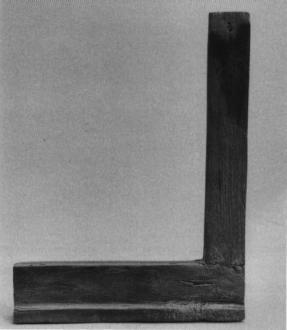 |
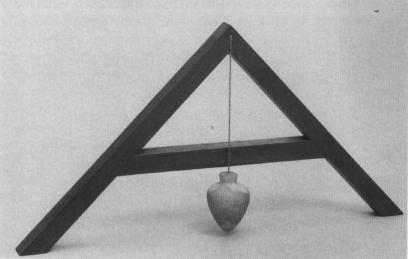 |
Fig. 6.5 Modern replica of a builder's square
from the Theban tomb of Mektira
(MMA acc. no 20.3.90) |
Fig. 6.6 Modern replica of a square level (MMA), probably
representing Cairo 27258. |
Boning Rods вИЩ When dressing blocks, Egyptian masons used
boning rods22 in order
to obtain completely flat planes, as shown in the representation of the
tomb of Rekhmira (fig. 6.7).23
Two people hold short pieces of wood; both pieces are the same length and
arc connected to each other at their tops by a string. One man is moving
a third rod of the same length over the block surface between the two other
rods. If there still are protruding parts, the third rod would show above
the line of the string. This kind of boning would probably have been done
crosswise over all four corners. It would not have been sufficient, however,
to level the stones. This task was probably done with the help of two level
boards,24 a method used
by masons even into this century.
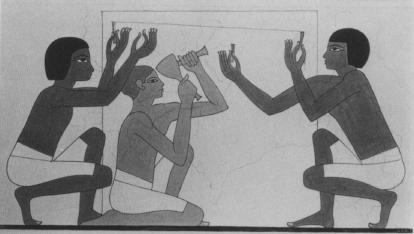 |
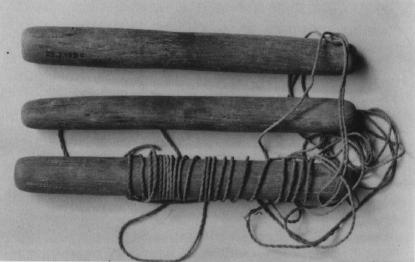 |
Fig. 6.7 Reconstruction of the scene of men working with
the boning rod
and dressing a limestone block (chisel painted yellow)
from the Theban
tomb of Rekhmira. (MMA acc. no 31.6.23) |
Fig. 6.8 Set of boning rods from the Hatshepsut temple
at Deir el-Bahari.
(MMA acc. no. 23.3.169) |
Numerous sets of boning rods have been found all over Egypt, from the
Old Kingdom on, and are practically all identical (fig. 6.8).25
An L-shaped perforation is drilled into two rods, beginning at the top
end and emerging on the side. The string is fed through the holes in the
sides and tied so that on each rod it emerges at the hole in the lop. They
are 10 to 13 centimeters long (fig. 6.9).
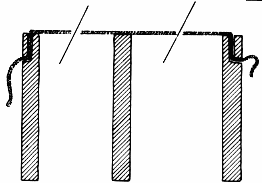 |
|
Fig. 6.9 Section through a set of boning rods.
|
Stocks has suggested that boning rods could also have been used for
the exact fitting of blocks with oblique rising joints to measure the constant
distance between the corner points.26
We have no actual evidence for this, and such measurements could have been
carried out with any string of practical length or with other primitive
instruments.
CUTTING TOOLS
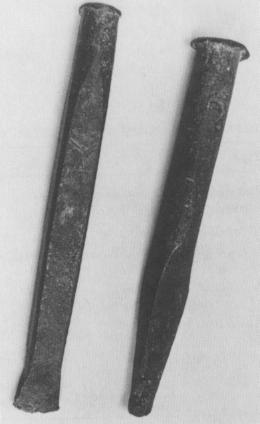 |
Fig. 6.10 Round bar chisels of the Eleventh and
Eighteenth Dynasties from Deir el-Bahari.
(MMA acc. nos, 30.8.115 and 27.3.12)
|
Metal Tools вИЩ Egyptian metal tools27
consisted of essentially unalloyed copper, arsenical copper, tin bronze,
and leaded tin bronze.28
A very high iron content is found occasionally and suggests that the tools
were made from unrefined metal.29
The question of the date when iron tools came into general use in Egypt
is much disputed.30 Specimens
of early iron are reported from Predynastic dates on. Fragments supposedly
of chisels from Saqqara are said to belong to the Fifth Dynasty, and pieces
of a pickax found at Abusir and broken tools from Dahshur are said to be
of the Sixth Dynasty. Since the circumвХЬstances of these finds are extremely
vague, the dating of the tools may be questioned, and they could as well
have been used by stonecutters of a much later period. A later date for
these tools is also suggested by the fact that iron objects from the tomb
of Tutankhamun were of poor quality and were considered to be so valuable
that they were set in gold.
Only from the end of the Eighteenth Dynasty is there a gradual increase
in the number of iron objects found in Egypt. In the Twenty-sixth Dynasty,
iron became as common as bronze. At the same time, the first iron tools
started to leave their traces on hard stones, and two tools of the seventh
century b.c. are known to be of steel, their date being questioned, howвХЬever.31
The next step was the introduction of Roman types of iron tools, which
differ considerably from the traditional Pharaonic tools.32
This development clearly shows that the tools of the Pharaonic period,
with which we are concerned, were made primarily of copper or bronze. The
question that must be considered, then, is to what extent metal chisels
were used in comparison with stone tools.
Metal chisels were used for stoneworking, and many have been found.
It seems not coincidental that the number of preserved metal chisels increases
with the beginnings of monumental stone building in the Third Dynasty.
Copper chisels (perhaps models) from tombs are known since the First Dynasty.33
We have to suppose that they were used for woodworking. Some of the chisels
from the Third Dynasty were certainly used for dressing stone, especially
those from the Djoser precinct.
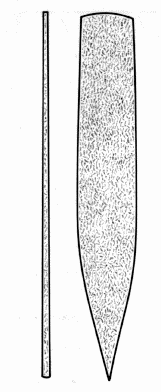 |
Fig. 6.11 Flat mortise chisel from
a foundation deposit of the
Mentuhotep temple at Deir
el-Bahari. (Luxor Museum)
|
The two main types used for dressing stone were the round bar chisel
(Petrie's type D) (fig. 6.10) and the flat mortise chisel (Petrie's type
B) (fig. 6.11). Both are represented by dozens of specimens, ranging from
the reign of Djoser to the New Kingdom. They were held in the hand and
struck with a wooden mallet. They had to be a "handy" size, and therefore
ranged from 16 to 25 centimeters long. Some were rather short and stout;
others more elongated.
The cutting edge of the round bar chisel is normally 1 to 2 centimeters
wide, but sometimes more pointed, and it produces a cavity of correspondвХЬing
width. In one operation, the successive cavities follow one another in
the same straight or slightly curved line. Successive equidistant parallel
lines are then repeated in the same manner until the tool has passed over
the whole surface. Traces of this tool are quite frequent.
The flat mortise chisel is pointed and was not meant for flattening
a surface but for cutting into it — that is, for producing features like
mortises, ledges, and corners. It was probably not driven at an angle but
more vertically.
From Petrie's rich collection, we learn about the existence of many
more chisel types.34
Most of them, however, were certainly not used for the production of building
stones but for sculpting or for woodworking. Only one type might still
belong to the tools of a stonecutter. It is the elongated, bare mortise
chisel, which can be rather small—7 to 11 centimeters—or up to 52 centimeters
long. The longer ones resemble a crowbar.35
Such chisels were used for cutting small and deep mortises and holes or
areas difficult to reach. Mortise chisels could also have been used by
carpenters.
Many chisels were not held in the bare hand but inserted into wooden
handles. Since a heavy blow would have driven the chisel deep into the
handle and thus broken it, such instruments could have been used only for
cutting soft material or would not have been used with a mallet at all.
It is unlikely that such chisels were frequently used by masons. In fact,
in repreвХЬsentations they are shown in the hands of carpenters and leather
workers.36
The list of examples in Table 6.1 is only a selection, with emphasis
on the early representatives of each type.
TABLE 6.1. EXAMPLES OF METAL TOOLS USED IN PHARAONIC STONEWORKING
| Type
|
Provenance
|
Date
|
Length (cm)
|
Museum
|
Publication
|
Round bar chisel
(Petrie's type D)
|
Djoser complex
|
Djoser
|
22.5—25
|
Cairo
|
Firth and Quibell,
Step Pyramid,
232—233, fig. 234, pl. 96 [3]
|
| |
Abusimbel (desert) |
Cheops |
24 |
Cairo 68754
|
A. Rowc, ASAE 38
(1938): 391-393. pl. 59 |
| |
Pepy II pyramid |
Pepy II |
? |
Cairo |
Jequier, Pepi II III, 48-49, fig. 47 |
| |
Deir el-Bahari |
Mentuhotep |
19.5 |
MMA 27.3.12
|
BMMA 23, part 2
(February 1928); 14, fig. 15 |
| |
Kahun |
Twelfth Dynasty |
14.6 |
University College, London 14240
|
Petrie, Tools and Weapons,
20, pl. 22 [80] |
Round bar chisel
(Petrie's type D)
|
Amarna
|
Amarna
|
24 |
Ashmolean
|
J. D. S. Pendlebury,
The City of Akhenaten III
(London, 1951), 82, pl. 72 (101) |
| |
Memphis |
Ramesses II |
14.8
|
University College, London
|
W. M. Flinders Petrie,
Memphis I
(London, 1909), pl. 28 [30]
|
| |
Deir el-Bahari |
Ramesses II
|
16.2 |
Royal Ontario Museum 907.18.26
|
Edouard Naville, The XIth Dynasty Temple at Deir el-Bahari
in (London, 1913), 18, pL 29 [7]
|
Flat mortise chisel
(Petrie's type B),
for levering pieces out
|
Beit Khallaf |
Djoser
|
17 |
? |
Garstang, Bet Khallaf, pl.16
[13, 16-18, 23, 24, 30, 31] |
| |
Djoser complex
|
Djoser
|
17 |
? |
Firth and Quibell, Step
Pyramid, 124—125, Fig.
11 [8],pl.93[3l |
| |
? |
Userkaf |
? |
BM 66208-66209
|
Introductory Guide to the
Egyptian Collections
(catalogue of the British Museum)
(London, 1969), 2o8, fig- 77 |
| |
Pepy II pyramid |
Pepy II |
? |
Cairo
54478- 54491 |
Jequier, Pepi II in, 48-49, fig- 47
|
| |
? |
Sixth Dynasty |
12.13 |
University College, London
|
Petrie, Tools and Weapons,
20, pls. 21 [23], 22 [71]
|
| |
Mentuhotep temple |
Mentuhotep |
18.8, 20.3, 20.5, 21 |
Luxor Museum
|
Arnold, Mentuhotep III:
Die Königlichen Beigaben (Mainz, 1981), pls. 79, 87a
|
|
Ghurab |
New Kingdom |
? |
? |
CEAEM, Fig. 263b |
Mortise chisel
(Petrie's type A),
for levering
pieces out from
distant parts
(only for
sculptors?)
|
Beit Khallaf
Djoser complex |
Djoser
Djoser |
7-10.6
10-11
|
?
? |
Garstang, Bet Khallaf,
pl.23 [1-5l
Lauer, Hist. Mon., 237-238, Fig. 66; Firth and Quibell, Step
Pyramid,
124-125, Fig. 11 [6-7],
pl. 93 [3l |
| |
Gebelein
Pepy II pyramid
|
? |
52 |
Cairo |
CEAEM, Fig. 263a |
| |
Pepy II pyramid
|
Pepy II
|
? |
Cairo |
Jequier, Pepi II III, 48-49, fig. 47
|
Wide chisel
(Petrie's
type C),
for sculptors (?) |
Beit Khallaf
Asyut or Meir |
Djoser
Middle Kingdom
|
8-10
? |
?
Khashaba
Collection |
Garstang, Bet Khallaf, pls.
16 [27-28], 23 [27-28] |
W. C. Hayes, "Selective Catalogue of Egyptian Antiquities from the
Collection of Sayed Pasha Khashaba, Assiut" (Metropolitan Museum of Art,
Typescript), pl. 45
| |
? |
Ahmose
|
18.5 |
University College, London |
Petrie, Tools and Weapons, 20, pl. 22 [68]
|
Stone Tools вИЩ From the earliest times down to the New
Kingdom and perhaps even later, stone tools played an important part in
Pharaonic stoneworking (Table 6.2). Despite the existence of metal chisels
since the Third Dynasty, stone tools certainly formed the majority. This
is mainly because the harder stones could be cut only with stone tools,
not just in the earlier periods but even in Saite times when hard stones
for sculpture, sarcophagi, and naoi were again highly esteemed.
TABLE 6.2. EXAMPLES OF STONE TOOLS USED IN PHARAONIC STONEWORKING
| Type
|
Provenance
|
Date
|
Size (cm)
|
Museum
|
Publication
|
Picks, axes, or
mauls with narrow
necks for handles
|
Djoser complex
|
Djoser
|
Up to 23
|
?
|
Firth and Quibell, Step Pyramid, 128, pl. 93 [6]
|
|
|
Meidum
|
Snofru
|
21
|
University College, London
|
Petrie, Tools and Weapons, pl.58 [74-86] |
| |
Giza
|
Fourth or Fifth Dynasty
|
13-15
|
University College,
London |
Petrie, Tools and Weapons,
pl.53 [75-77); Junker,
Giza
ix, 18, pl. 6d;
Reisner, Mycerinus, 236
|
|
|
Thebes, Mektira
|
Eleventh Dynasty
(?)
|
30
|
MMA 20.3.190
|
|
|
|
Thebes, Mektira
|
Eleventh Dynasty
(?)
|
?
|
Cairo
|
CEAEM, fig. 266
|
| |
Beni Hasan
|
Middle Kingdom
|
18-25
|
University College,
London
|
Petrie, Tools and Weapons,
pl. 53 [83-86]
|
| |
Thebes
|
Middle or New Kingdom
|
35-43
|
Cairo 14737,
14749, 34"8
|
H. H. Seaton-Karr,
ASAE 6 (1905): 176-179
|
| |
Deir el-Bahari
|
Middle or New Kingdom
|
18.5-24
|
Cairo 64901-64906
|
Charles T. Currelly, Stone
Implements (Cairo, 1913),
276, pl. 63
|
| |
Thebes
|
New Kingdom
|
?
|
?
|
Edouard Naville, The XIth
Dynasty Temple at Deir el-Bahari
in (London, 1913), pl. 29[8]
|
| Dolerite balls as pounders
|
Djoser complex
|
Djoser
|
Diameter, 10,
maximum 40
|
?
|
Firth and Quibell, Step
Pyramid, 128, pl. 93 [7]
|
| |
Giza
|
Fourth or Fifth Dynasty
|
?
|
?
|
Junker, Giza IX, 19, pl. 6d; Giza X, 16
|
| |
Lisht
|
Twelfth Dynasty
|
Maximum 30
|
Lisht/Saqqara
|
Unpublished
|
| |
Aswan
|
New Kingdom
|
20-46
|
?
|
Engelbach, Aswan Obelisk,
11-12; CEAEM, fig. 266
|
Rammers (two-
handed pounders)
(granite)
|
Saqqara
|
Old Kingdom (?)
|
?
|
?
|
Engelbach, Aswan Obelisk,
pl. 4 [2]; Engelbach,
Problem of
the Obelisks,
fig. 10
|
|
|
Mycerinus complex
|
?
|
Height, 31
|
?
|
Reisner, Mycerinus, 236-237, pl.
236-237, pl. 20a-c
|
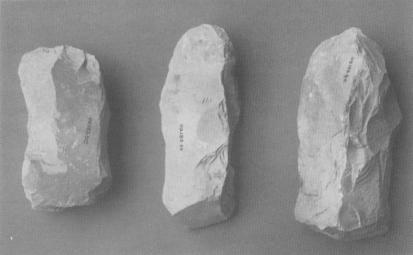 |
Fig. 6.12 Three limestone ax heads from Quma, Eighteenth Dynasty.
(MMA acc. nos. 09.183.5A-C)
|
Four main groups of tools can be established from the numerous objects
found in nearly all Pharaonic construction, quarry, and mining sites: picks,
pounders, two-handled rammers, and grinding stones.
The stone pick (ax or maul) (figs. 6.12-6.16) is an elongated implement
of granite, chert, basalt, quartzite, or even hard, silicified limestone
that is 30 to 50 centimeters long. It has a head more or less shaped, a
contracted neck, and a pointed or wide cutting part. Representations (fig.
6.13),37 actual objects
(fig. 6.14, 6.15),38
and particularly the existence of the conвХЬtracted neck indicate that the
stone was not held in the hands but between two sticks attached to the
stone at the neck with a leather strap. Most examples are only roughly
shaped primitive tools, although others are more carefully made in regular
shapes and even with smoothed surface.
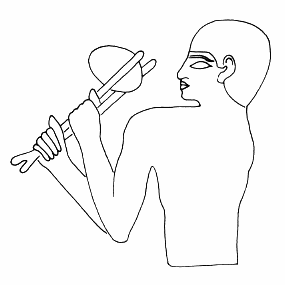 |
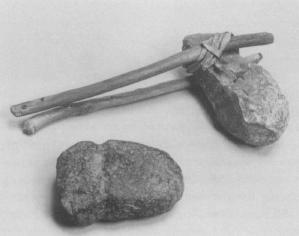 |
Fig. 6.13 Sculptor dressing a statue with a stone hammer,
as depicted in the tomb of Ti. |
Fig. 6.14 Quartzite ax with original handle from the tomb
of Mektira, Twenty-second to Twenty-sixth Dynasties,
and diorite ax head from the site of the pyramid of
Amenemhat I at Lisht, Middle or New Kingdom.
(MMA acc. nos. 20.3.190, and 15.3.832)
|
This heavy tool was very effective in rough work, such as excavating
tunnels and shafts for tombs or breaking the separation trenches for buildвХЬing
blocks in quarries. The curved line produced by wielding the ax can still
be seen on many unfinished surfaces, even on the surface of unfinished
walls, indicating that skilled workers using this bulky tool could achieve
a certain degree of flatness on the stone. One may even suggest that the
completely flat and densely picked ("hammer dressed") surfaces of hard
stones such as basalt were produced with such picks (figs. 6.12, 6.14).39
Bronze picks, quite common in Minoan Crete and in later MediterraвХЬnean
cultures, seem not to have been used in Pharaonic Egypt.
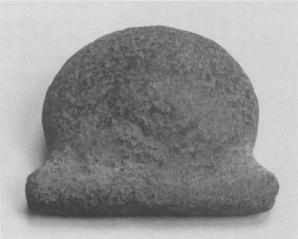 |
Fig. 6.15 Gabbro hammer head from the site of the pyramid
of Amennemhat I at Lisht, Middle or New Kingdom.
(MMA acc. no. 22.1.819)
|
Pounders are roughly or completely spherical balls, mainly of dolerite
(fig. 6.16). They have a diameter of 15 to 30 centimeters and weigh about
4 to 7 kilograms and could only be lifted with two hands. The largest
one known to me has a diameter of 40 centimeters.40
They were found at most of the construction sites of the Old and Middle
Kingdoms. Their apвХЬpearance at the quarrying sites of the obelisks of the
New Kingdom41attests
that they were still in use. Pounding was the main method for workвХЬing
granite and perhaps other hard stones as well (not yet clarified).
Pounders could also be used with a helve. This is shown in ancient repreвХЬsentations42
as well as by the shape of the tools. Some have knobs for the leather strapping
and are rather flat, resembling an ax.
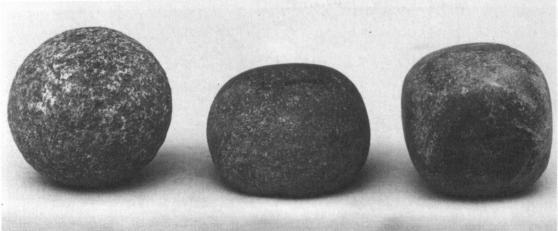 |
Fig. 6.16 Dolerite pounders from the area of the pyramid
of Amenemhat I at Lisht, Twelfth Dynasty.
(MMA acc. nos. 11.151.733-735)
|
Junker believed that these dolerite balls were actually used under heavy
stones as rollers.43
This method seems to have worked, as Junker's sucвХЬcessful experiments proved.
We may be sure that the Egyptians knew this method and made use of it.
But it certainly was neither the only nor the main use of these dolerite
balls. This is confirmed by their surfaces, which show clear marks of pounding,
and also by the fact that they are found in areas that would not have provided
the completely flat stone surface necesвХЬsary for rolling a heavy monument
on stone balls.
From two preserved examples44
and a representation in the tomb of Ti,45
we know of the existence of a very heavy granite rammer with two handles
(fig. 6.17), quite similar to a mighty ramming tool of wood, used in more
recent times before the introduction of compressor rammers. BeвХЬcause pounding
granite with dolerite balls leads to the gradual destruction of the tool,
one wonders if such carefully made rammers were used for that kind of work
at all. The tool may have been a kind of hammer, used, for example, to
drive poles into the ground. This use might be suggested by the representation
in the tomb of Ti, in which the rammer is used in shipbuilding, apparently
to connect the boat timber with wedges. A devasвХЬtating force was produced
by a dolerite rammer used by late Middle KingвХЬdom tomb robbers at Lisht.
It had four knobs around which ropes had to be slung for lifting the heavy
stone, but two men were needed to do that (Fig. 6.17).
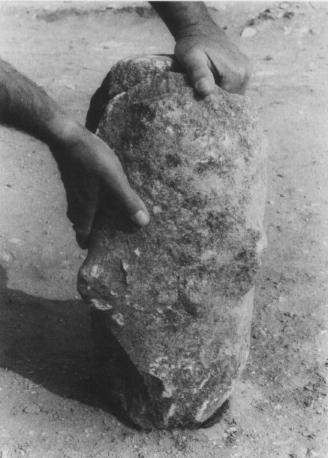 |
Fig. 6.17 Huge dolerite rammer found in the tomb of
Metuhotep at Lisht, Middle to New Kingdom. |
The final surface treatment of Pharaonic stone building was carried
out with grinding stones.46
In general, one has to differentiate between the initial, rougher work
of grinding and the second step of finer surface polishing. Grinding could
be done with all kinds of stone; only the hard ones, such as alabaster,
marble, granite, diorite, graywacke, and basalt, could be polished.
For the grinding of limestone and sandstone, grinders made of sandвХЬstone
could be used. The treatment of harder stones required the use of abrasive
sand. Even the grinder itself would probably be of a harder subвХЬstance.
The sand could be dry, but dampened sand would have produced less dust
and cleaner work. The fine polishing was probably carried out without water.
Grinding stones of many different materials have been found. The most
common ones are sandstone or quartzite. Some grinders were carefully shaped;
some even have a handle and were used for special purposes, such as sculpting.
The grinding of large surfaces, such as the walls of temples, was carried
out with hand-sized rough sandstones, which when used acвХЬquired a completely
flat underside and were soon useless as tools. The remaining casing blocks
of pyramids have been exposed to weathering so much that it is difficult
to determine the degree to which they had originalвХЬly been smoothed. At
the pyramid of Meidum, large areas of the casing have recently been unearthed
in quasi-original condition. The surfaces had been only flattened with
stone picks and possibly chisels.
Isler studied the procedure of grinding the surface of the Luxor obelisks.
Because two of their faces swell out, he assumed that this lateral convexity
was due to the grinding motions, which disregarded the effect of gravity
against the edges and produced slightly curved planes.47
Grinding was also carried out after repairing a wall surface with patches
or plaster in order to blend the repaired areas into their surroundings.
To achieve highly polished hard stone surfaces, several grinding and
polishing phases with different grinders and grinding materials were necвХЬessary.
One may assume that sculptors and masons developed their special private
formulas for the procedure.
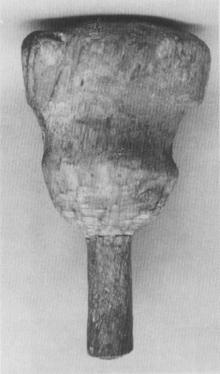 |
Fig. 6.18 Wooden mallet, provenance
unknown. (MMA acc. no. 10.130.1013) |
As discussed above, one would expect that stone chisels (flint, chert)
were used for carrying out (the finer surface work on limestone and sandstone.
The great number of crescent-shaped flint tools found in the Djoser comвХЬplex
that probably date to the Third Dynasty is impressive. They were apparently
used for cutting the fluting of columns.48
Flint chisels whose shape seems to be suited for finer work in stone have
rarely been found,49
and
their absence from the major construction sites of the Old and Middle Kingdoms
is remarkable.50 Thus
although we should exclude the use of metal tools for cutting hard stone,
we remain unable to present the alterвХЬnative stone tools.
Mallets вИЩ Since the beginning of sculpting, the wooden
mallet has been used by the sculptor to strike the chisel.51
The Egyptian version consists of a rounded handle cut from the same piece
of wood as the head of the mallet (fig. 6.18). The head is more elongated
than the modern instrument and quite frequently shows a rough, ring-shaped
groove that could have been carved for a metal band, which prevented the
mallet from splitting. Apparently no mallet has preserved such a band,
however, and one might suggest that the groove was caused by the impact
of the chisel. Examples from Pharaonic Egypt are known in great numbers,
and the larger museвХЬums are in possession of dozens of them.52
The most common type of mallet head has a bell-shaped or half-circle-shaped
section. The older examples known—from the First Dynasty to the end of
the Old Kingdom from Deshasheh (fig. 6.19) and depicted in many sculptors'
and shipbuilders' scenes of the Old Kingdom53—are
more slender and elongated.
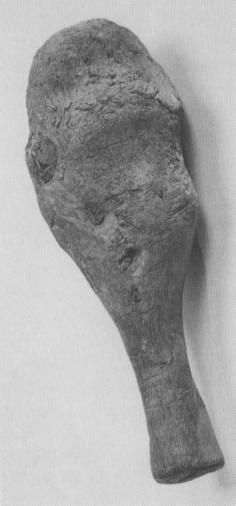 |
Fig. 6.19 Elongated wooden mallet from
Deshasheh, late Old Kingdom.
(MMA acc. no. 37.4.65) |
One mallet has even preserved the owner's marks +<&A a mixture
of invented signs and the hieroglyph of the square level.54
Drilling Tools55
вИЩ In prehistoric times, the Egyptian craftsmen had develвХЬoped great
skill in drilling hard stone for the manufacture of vessels.56
For a drilling tool, they used a forked axis that held a half-moon-shaped
drillвХЬing stone of sandstone or flint; the drilling stone moved with a
bow, and the movement was aided by pending weights. Drilling in architecture
spread with the increase of stone building from the Third Dynasty on. The
main tool seems to have been a tube attached to a long wooden staff, again
driven by bows.57 Since
no actual drilling tube has ever been discovered in Egypt, the material
used for the tubes remains unknown. The narrowness of the tubular-shaped
slots and the greenish color of grains of quartz sand preвХЬserved in the
drill hole of an unfinished alabaster vase suggest copper or bronze tubes.
Wooden tubes are a possibility, but achieving a wall thickness of i to
5 millimeters in wood would have been difficult.
Shaw suggested that Minoan drills probably did not consist of bronze
but of a section of reed or bamboo swiftly rotated with sand or emery and
a lubricating agent such as water or oil.58
Bamboo was unknown to the Egyptians, however. Whether the Egyptians used
loose (wet?) quartz sand, fixed points of emery, or even diamond has been
investigated in the pracвХЬtical experiments of Gorelick and Gwiimeit. They
found that the typical regular concentric lines on drilled cores of granite
could he reproduced by a copper tube charged with emery only when used
in a water slum or in olive oil. Concentric cutting lines were also present
after drilling with corвХЬundum and diamond. Sand and crushed quartz must
therefore be ruled out as possibilities, since they do not produce concentric
abrasion lines. when used either dry or wet.59
These preliminary findings raise questions as to which one of the abrasives—emery,
corundum, or diamond—was used, and also whether it came from some unknown
source in the Egyptian deserts or was imported.60
Drilling hard stone was carried out so freвХЬquently, however, that one has
to assume that the abrasive material was easily available in sufficient
quantities. This requirement does not favor emery, corundum, or diamond.
Stones that were drilled for architectural purposes were alabaster,
limeвХЬstone, sandstone, granite, basalt, amphibolitc, and diorite, which
shows that the hardness of stone placed no limits on the ingenuity of the
Egyptian builders. A decision to drill was probably economic, since the
consumption of metal would have been considerable. This consideration prevented
the Egyptians from using drilling in the production of stones—for example,
in separating blocks from the bedrock in the quarry.
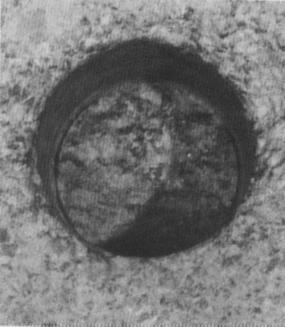 |
Fig. 6.20 Drill hole with stump of the drill core from
a Ramesside granite door jamb from the Asasif,
diameter 7.5, depth 10.3 centimeters.
(MMA acc. no. 13.183.2) |
Petrie observed that in Deir el-Bersheh a rock platform had been dressed
down by cutting it away with gigantic tube drills 45 centimeters in diame
ter.61 Drilling had to
be used, however, for producing holes for pivots, door bolts (fig. 6.20),
round cramps, nails for the application of sheet metal, and the insertion
of emblems.62 Alabaster
and limestone slabs could be drilled with a pattern of round holes to produce
"windows."63 The only
larger-scale activity with drilling was probably the production of the
inteвХЬrior of sarcophagi in the Third and Fourth Dynasties (Fig. 2.2Q).64
It was probably carried out- by a large number of closely set drill holes
about 12 centimeters in diameter. The procedure had to be done in four
to six steps because of the limited length of the drilling tubes and the
need to break off the still-standing cores of stone.
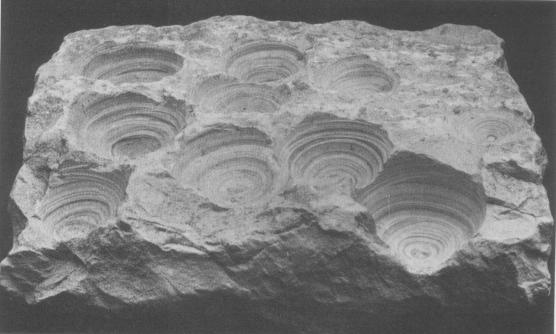 |
Fig. 6.21 Limestone block with ten boring sockets from
the mastaba of Perneb at Saqqara.
(MMA acc. no. 14.7.146) |
As noted, no actual drilling tubes have so far been observed. Their
use is definitely attested by the traces of the tool left on the stone
and the drilling cones found mainly in Old Kingdom sites.65
Unexplained are traces of drilling operations left on the rough surface
of irregular limestone blocks in the enclosures of Djoser and Snofru (fig.
6.21).66 They mostly
appear in irregular groups, some so close that they overlap. They look
as if the stones had been under an object that was drilled in a way that
the drilling tube completely penetrated the object and then reached the
underlying stone. This underlying stone was apparently used for several
drilling operations.
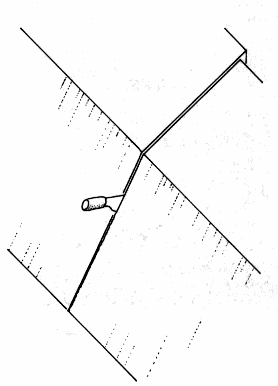 |
Fig. 6.22 Use of a saw to plane the joint between
two casing blocks. |
Sawing Tools67вИЩ
Lauer already suspected that the close joining of limeвХЬstone casing blocks
could have been achieved as early as the Third Dynasty by a method of sawing
with a copper blade drawn through the front edge of the joints (fig. 6.22).68
When the lower end of the joint was reached, the saw quite frequently cut
into the foundation blocks, leaving a cutting line protruding an inch from
the front line of the blocks. This method was certainly practiced for the
casings of the Mastabat el-Fara'un (fig. 6.23) and of the pyramids of Unas
and Senwosret I. We do not know the instrument that was used but suspect
that it was a short, knifelike saw with a wooden handle.
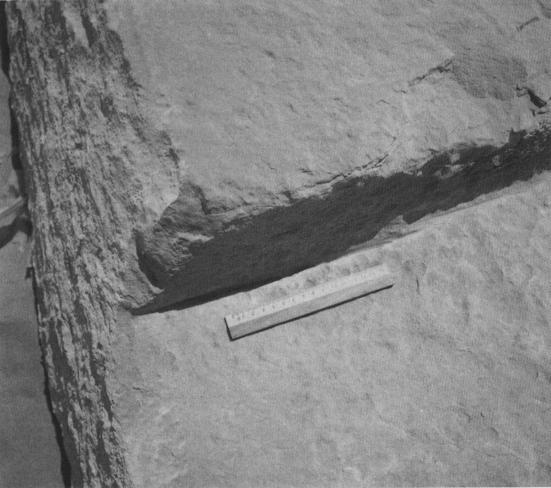 |
| Fig. 6.23 Curved sawing marks in the stepped top face
of a casing block of the Mastabat el-Fara'un |
Zuber confirms that the curved tool marks suggest the use of a saw,
not a cable. Since the cut never exceeds a width of half a centimeter,
the use of an instrument with teeth of flint set into a metal frame is
ruled out.69 Sawing of
softer stones was apparently not problematic and was carried out quite
frequently; the sawing of harder rocks was, however, used only for special
cases. The alabaster sarcophagus of Sekhemkhet (Third Dynasty) shows saw
marks,70 as do the alabaster
altars in the sun temple of Niuserra.71
Even
harder stones could be completely cut by this method. The granite sarcophagus
of Cheops72 and two others
of the Fourth Dynasty (fig. 6.24)73
were
definitely sawed, as were the granite portcullises of the Cheops PyraвХЬmid74
and the basalt paving blocks in the mortuary temples of Cheops75
and
Niuserra.76 Also the
famous triads of Mycerinus made of graywacke show traces of sawing.77
 |
Fig. 6.24 Cutting wood with a heavy saw (tombs of Beni
Hassan), and
sawing the lid from the bottom of a granite sarcophagus. |
Petrie estimated that the sawing blades used for the sarcophagus of
Cheops must have been 2.4 meters long. They were probably toothless and
used with sand as an abrasive. The experiments by Stocks78
add to Petrie's ideas that the sawing power was not exercised so much by
the saw itself as by the quartz sand. Nevertheless, the loss of metal must
have been considвХЬerable and the method so expensive that it could have
been carried out only on royal monuments.
Unfortunately, no saws of this size have been discovered in Egypt.79
But smaller examples, especially in the form of, tomb models (and
intended to be used for sawing wood), are known from the Third Dynasty
on.80 Sawing stone has
remained a method common in stonework from Roman times81
until
today.
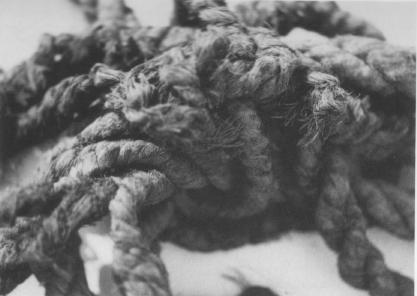 |
| Fig. 6.25 Knot of a rope from the tomb of Mentuhotep
at Lisht. (Unpublished) |
MOVING IMPLEMENTS
Ropes вИЩ Handling building materials, especially stone,
depends on the existence of ropes strong enough to permit all kinds of
maneuvers (fig. 6.25). Unfortunately, our knowledge about ropes in ancient
Egypt is reвХЬstricted because few specimens have been collected and even
fewer have been properly studied.82
All examples known were made by the method of twisting and countertwisting
fibers, each yarn being twisted in the same direction, and only very few
were made by plaiting.83
As material of cordage, dom palm fibers (Hyphaene thebaica),
reed, flax, grass, esparto grass, halfa grass (Desmostachya bipinnata),
and papyrus (Cyperns papyrus) are mentioned. Ropes found with the
boat of Cheops were made of half a grass.84
Naturally, ropes of a small diameter are more frequent, but we also
know of thick ropes. Papyrus ropes found in 1942 and 1944 in the Tura caves,
presumably of Ptolemaic or Roman date, had a circumference of 20.3 centimeters
and a diameter of 6.35 centimeters. They consisted of three strands of
a number of split and twisted papyrus culms.85
A rope made of five strands was recovered from the boat pit of Cheops.86
A "mammoth piece of cordage" of the Nineteenth Dynasty was found at Deir
el-Bahari; it had a diameter of 6.8 centimeters.87
There is no question that the Egyptian builders made use of even stronger
ropes for the movement of such heavy monuments as colossal statues and
obelisks. We have only literary sources, however, for evidence of such
ropes; references are made to high-quality ropes 1000 and even 1400 cubits
(525—735 meters) in length88
to be used for the royal bark. Engelbach calculated:
As to the size of the ropes required for the rolling out of the obelisk,
all we can do is to obtain a very rough idea as to it. If they spread the
men out slightly fanwise, I do not see how they could have used more ilian
40 ropes. The strain per rope will be, as we have seen. 29 x 1170 40 =
6.-, tons per rope.
The rope used was probably the very best palm-rope, newly made. The
safe load which can be put on coir rope, which is of about the same strength,
is given by the formula: Load in cwts- (circumference in inches) divided
bv 4. SubstitutвХЬing, we have 6.5 X 20 X 4 = C2
which gives the circumference of 22.8 inches (58 cm) and a diameter of
7 1/4 inches (18.4 cm). If such a rope were used it would require handling
loops on it.89'
In contrast to the reconstruction of such heavy ropes are the calculations
for the ropes used for lowering the obelisk of Thutmosis III in front of
Pylon VIII at Karnak, which was removed by Roman engineers in a.d. 330.90
The result of these calculations is that the ropes were about 85 to 90
meters long and had a circumference of 18 centimeters and a diameter of
5.7 centimeters, with a normal working strength of 6 to 7 tons and a breaking
resistance of 20 tons. Such ropes were used in modern seafaring before
the introduction of synthetic ropes.
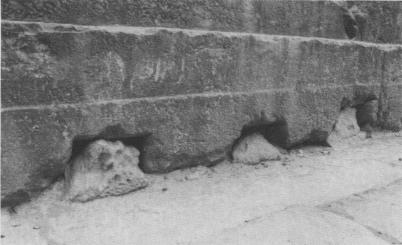 |
Fig. 6.26 Series of very large lever sockets at a huge
limestone
block in the mortuary temple of Mycelinus. |
Levers вИЩ The use of wooden levers to lift, shift, or turn
over stone blocks was quite common in ancient Egypt.91
Instruments that can be identified as levers, however, are rarely recognized
in excavations because they would usually have looked like ordinary beams
with an obliquely chopped or chamfered end. There are a few examples,92
and even a bronze crowbar 67.2 centimeters long was discovered at Amarna.93
Levers have left unquestionable traces in the blocks themselves (figs.
4.10, 4.i i). These traces are in the shape of shift cuttings and lever
holes, frequently seen either on the side face of the blocks that were
lifted or pushed or on the top surface of blocks that had stones moved
over them. Sometimes both occur together.94
There are also cases where the lever holes appear along the upper edge
of a side surface just a few centimeters from the edge.95
Such holes helped to place the blocks exactly against their adjacent blocks.
Ordinary blocks with bigger dimensions, such as the casing blocks of
the pyramid of Senwosret I, were provided with only one hole, which was
positioned at the lower edge of one of the side faces. It was always hidden
by the adjacent block so it could not be seen when the building was finished.
Even in such a concealed place, however, it was often carefully patched
with mortar and small stones after the placement of the block.96
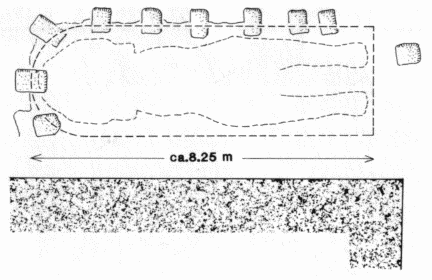 |
Fig. 6.27 Series of ten lever sockets in the rock in
front of the Chephren
valley temple, probably for positioning a sphinx. |
Larger blocks had to be moved with the help of more than one lever from
one side. There are examples of blocks with up to seven lever holes along
one side (fig. 6.26).97
The supposed sphinxes in front of the valley temple of Chephren are surrounded
by nine sockets from the front and the short sides in order to push the
monuments against the temple facade (fig. 6.27).98
The alabaster socle in the colonnade of Taharqa at Karnak was levered into
place by two pairs of levers.99
In order to allow room for the operation, trenches had to be dug for each
lever around the block. The pedestal of the colossus of Amenhotep III in
front of Pylon X weighs 90 tons and was moved with two levers on each side.
Judging from the sockets, the levers were 20 X 30 centimeters thick.100
A block from the entrance chapel of Senwosret I weighing 45 tons has three
lever holes of 20 x 34, 27 X 27, and 22 x 25 centimeters.
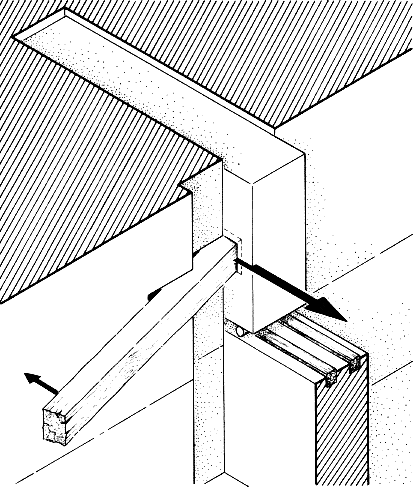 |
Fig. 6.28 Lever sockets in portcullises and passage walls
of a Twelfth
Dynasty tomb at Lisht enable the closing of the corridor. |
The use of such gigantic levers, which were pulled downward with fixed
ropes by a group of about ten men each, was demonstrated when Legrain had
the upper part of one of the Hatshepsut obelisks moved.101
Levers were also used for lifting. But did the Egyptian builders know how
to raise blocks by rocking them up with the help of two supports near the
center? Petrie calculated that by this method the fifty-six ceiling blocks
of the crypt of Cheops weighing 54 tons each could be lifted by ten men
with crossbars, since they would have to lift only 5 tons each time.102
Levers were also used to push portcullises out of their wall niches in
order to close tomb passages. For this purpose, a system of lever sockets
had been prepared (fig. 6.28).
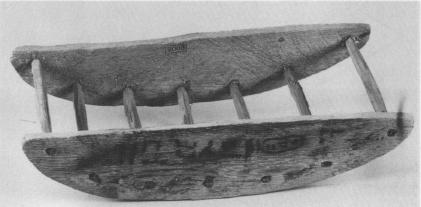 |
Fig. 6.29 Model of a rocker from a foundation deposit
of the Hatshepsut
temple, Deir el-Bahari. (MMA acc. no. 96.4.9) |
Rockers вИЩ In foundation deposits of the Eighteenth Dynasty
are found little models of a wooden appliance that is usually called a
rocker (Fig. 6.29).103
The model consists of two parallel boards with rounded underвХЬsides that
are connected to each other by up to six cross sticks. Because no traces
of the real instrument have ever been discovered and no representaвХЬtions
of its use have been noticed, its original si/e and purpose are unвХЬknown.
Nevertheless, Egyptologists and others have speculated much on this instrument.
There are two main theories.
The most common opinion is that rockers were large and could be used
for "rocking up" a building block.104
Loaded with a block, the rocker would have been rocked back and forth,
and shims would have been positioned under the raised runners alternating
left and right. In this way, a rather small team of workmen would have
been able to raise a block with moderвХЬate effort and in good lime. This
theory naturally appears in connection with pyramid building and may even
be called the backbone of most such theories. In general, one assumes that
the pyramid steps produced by the backing stones would have functioned
as a staircase to rock up the material for the courses above. One has to
keep in mind, however, that in actual work, it might not have been so easy.
One has to visualize that the steps are—depending on the angle of the pyramids
(that is, 50 to 60 degrees)— high rather than wide. Also, only for the
first one to ten courses of a pyramid are the steps wider than 50 centimeters.
This space on a steep pyramid is not sufficient for the safe handling of
a rocker loaded with a block 50 x 70 X 100 centimeters, which is a weight
of nearly i ton. FurtherвХЬmore, at the end of each rocking maneuver, the
rocker would have stood on a pile of wooden shims or beams the height of
a pyramid step. The fall of a loaded rocker would have wiped out all working
teams below. The loss of life and equipment might not have concerned the
pyramid builders, but the interruption of work certainly would have. Fitchen,
recognizing this problem, stressed the need to stabilize the pile of shims.
He suggested vertical timbers fixed in sockets on the surface of the underlying
block course. No such sockets on pyramid casings or core blocks have ever
been noticed. Another basic question is whether a heavily loaded rocker
standвХЬing on shims or wedges could still be rocked at all.
One might suggest, therefore, that rockers could have been used only
on particularly wide and specially equipped steps—that is, on a staircase
that was never provided by the pyramid itself, but only by masonry added
at a lesser angle from outside the pyramid slope.
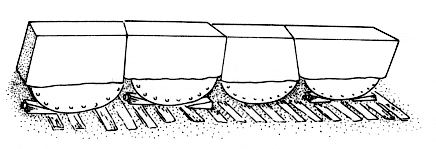 |
| Fig. 6.30 The use of rockers as proposed in CEAEM, figs.
107-109 |
Engelbach presented another theory, based on tests with a model (Fig.
6.30).105 Arranged in
a long line, many rockers would carry a whole course of wall blocks when
they were dressed. The rockers would have permitted the stone masons to
test, tit together, or move about the blocks, especially in cases where
oblique joints had to be produced. Thus the whole course could have been
assembled beforehand. Engelbach's theory is not convincвХЬing, however. The
preparation of whole courses of blocks for larger projвХЬects—such as temple
walls, pylons, and pyramids—on the ground in front of the building would
have required too much organization to be really useful. Instead, one might
follow Petrie's suggestion that "for shifting large building stones the
Egyptians seem to have placed them on a cradle of wood, so that they could
be readily twisted round, drawn along, or rocked up an inclined plane."106
Another possible interpretation of the model rockers is that they repreвХЬsent
in a simplified way nothing other than ordinary sledges. This would explain
why no real rockers have been discovered. Perhaps real rockers never existed.
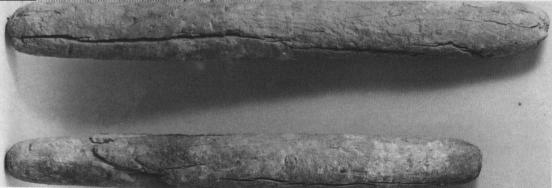 |
| Fig. 6.31 Pair of secamore rollers from Thebes (MMA acc.
nos. 28.3.3, 4) |
Rollers вИЩ In Pharaonic Egypt as in technologically similar
cultures,107 the use
of wooden rollers was quite common (thev are even used today), and many
rollers have been excavated in Egypt (fig. 6.31).108
They are short and have rounded ends, to prevent their catching. They have
a diameter of about 10 centimeters, indicating the range of weights that
could be moved by this method. Rollers are not easy to operate on uneven
or soft ground, so clearly the most suitable surface would have been flat
stone or a double row of beams arranged as tracks in the direction of movement.
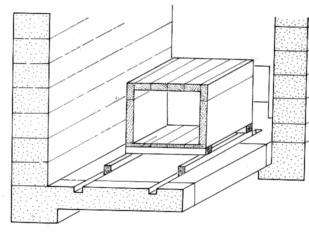 |
Fig. 6.32 Placing a sarcophagus with rollers on guiding
beams, at the Middle Kingdom tombs of Qattah |
Such skid poles were still found in position (or at least the grooves
cut for them) in several places, mostly near or under sarcophagi (figs.
6.32, 6.33)109 or at
the entrance of pyramid corridors, where they obviously served to roll
the closing block into position (fig. 6.34).110
In the secondary tomb of the "Mastaha du nord" at Lisht, the closing blocks
of the crypt ran on a pair of parallel poles that are still in position.
In both cases, neither the sarcophagus nor the sealing stone could be pulled
with ropes from the front but had to be pushed from behind, which was enormously
simplified by the use of rollers. No skid poles or their grooves were noticed
in other places, suggesting that the use of skid poles and rollers was
restricted to work under such special conditions. But one would assume
that building blocks were rolled in position whenever transport sledges
had to be left behind—for example, on top of walls or pyramid stumps under
construcвХЬtion. That blocks could also be moved on rollers in quarry caves
is attested by the discovery of a limestone block in one of the Tura caves
that was still resting on rollers. Unfortunately, the discovery was made
under unfavoraвХЬble conditions and never recorded.111
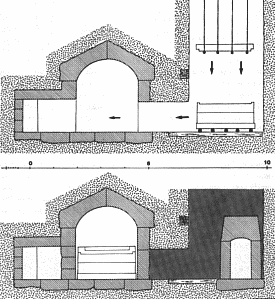 |
Fig. 6.33 Moving the sarcophagus of Senwosret III from
the construction shaft into the burial chamber on rollers
and guidance beams. |
There is a painting of a burial procession in which a coffin canopy
standвХЬing on a sledge is pulled over rollers.112
This combination might occasionвХЬally have eased transport problems, but
was certainly not the rule. The handling of rollers may also have been
depicted in the tomb of Rekhmira, but the damaged representation no longer
shows if the rollers were put under building blocks or under a sledge.'113
For heavy monuments, such as obelisks and colossal statues, weighing hundreds
of tons, the rollers would have been complete tree trunks of the hardest
available wood. Otherwise, they would have soon been squashed, and the
consumption of trees would have been enormous. In an actual experiment
to move a block of 32 tons, which was carried out in 1979 in France (see
n. 21, p. 102) trunks of oak 40 centimeters thick were used. During the
operation, the block was conвХЬstantly rolling on four to six such trunks,
arranged at close distances. Bronze rollers would have better sustained
such weights. The only ones I know were found in the royal tombs of Tanis.114
They may have been exceptional.
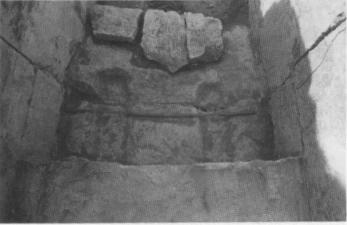 |
Fig. 6.34 Grooves for the guidance beams for rolling
in the
closing block of the pyramid of Amenemhat III at Dashur. |
Sledges вИЩ To move heavy loads on sledges appears to us,
who now use them only in snow, a hopelessly outdated technology. But the
days when such sledges were still commonly used are not really so long
ago. For example, we know that in the quarries of Carrara, heavy blocks
of marble were lowered on a lizza in 1929.115
These sledges carried well over 25 tons. They were constructed of oak,
holm-oak, or beech; were 6 to 12 meters long; and were pulled by as many
as fourteen pairs of yoked oxen.
 |
| Fig. 6.35 Sledge found south of the pyramid complex of Senwosret III at Dashur. |
Based on the great number of representations, the frequent use of the
hieroglyph  (from tm.t [sledge]), and a few objects
found, sledges were the main instrument for moving heavy loads in Pharaonic
Egypt, as in other countries of similar technological level.116
Three real sledges have been excavated in Egypt. The biggest one, 4.2 meters
long, was buried near the pyramid of Senwosret III at Dahshur, apparently
after having served for the transport of some heavy burial equipment (fig.
6.35).117 It consists
of two runners with a diameter of 12×30 centimeters, connected by four
crossbeams, attached with tongues and grooves. All the beams have slotted
holes that could be used to fix ropes for securing the load or for pulling.
But no hole for the main pulling rope at the front of the sledge is visible.
(from tm.t [sledge]), and a few objects
found, sledges were the main instrument for moving heavy loads in Pharaonic
Egypt, as in other countries of similar technological level.116
Three real sledges have been excavated in Egypt. The biggest one, 4.2 meters
long, was buried near the pyramid of Senwosret III at Dahshur, apparently
after having served for the transport of some heavy burial equipment (fig.
6.35).117 It consists
of two runners with a diameter of 12×30 centimeters, connected by four
crossbeams, attached with tongues and grooves. All the beams have slotted
holes that could be used to fix ropes for securing the load or for pulling.
But no hole for the main pulling rope at the front of the sledge is visible.
 |
Fig. 6.36 Sledge for a shrine, from a deposit south of the
pyramid of Senwosret I at Lisht. (MMA acc. no. 24.1.84) |
A smaller sledge, made of cedar wood, was excavated south of the pyraвХЬmid
of Senwosret I at Lisht (fig. 6.36).118
It is only 1.73 meters long and 0.78 meter wide and has only two crossbeams.
An additional round pole attached in front of the front crossbeam was used
for fixing the pulling ropes. A number of slots would have secured the
object to be moved with the help of dowels. This sledge was made to carry
a shrine or a similar object but was never used for real transport, since
the undersides of its runners show no traces of wear. Remains of color
indicate that the sledge was painted pink.119
Petrie excavated a portion of a large sledge for dragвХЬging stones that
was lying in the debris of the pyramid of Hawara and was made of reused
boat timber.120
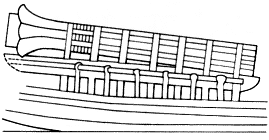 |
Fig. 6.37 Granite column on a sledge travelling
in a boat from Aswan to the pyramid temple of
Unas, as depicted in the Unas causeway. |
Most of the Egyptian representations of sledges show the transport of
funerary equipment, such as Ka statues, coffins, canopic boxes, and other
shrines.121 They are
pulled by men, oxen, or both. But there are also representations of the
transport of building materials. The oldest scene, in the causeway of Unas
(fig. 6.37)122 shows
granite columns and architraves on their boat trip from Aswan to Saqqara.
The architraves and the 6-meter-long columns are tied up on sledges, which
would therefore have been about 7 meters long.
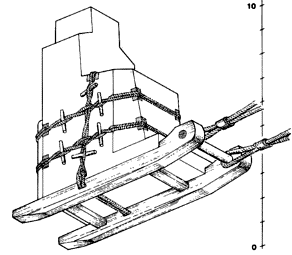 |
Fig. 6.38 Reconstruction of the sledge for
transporting the colossus of Djehutihotep |
Another famous transport scene is that in the tomb of Djehutihotep at
Bersheh (fig. 6.38).123
It shows the seated alabaster figure of the monarch tied to a huge sledge,
which is pulled by i 72 men walking in four columns. The ground immediately
in front of the sledge is watered for ease in gliding. There are no indications
of the use of rollers for road construction. The statue may have been 7
meters high and weighed about 58 tons. It is amazing that the four pulling
ropes radiate from one point, since four ropes fixed to a draw bar might
have been expected. To increase the number of men, as was necessary for
large monuments, this draw bar would have projected on both sides of the
sledge so that many more paralвХЬlel ropes could be pulled at the same time.
To the side, a heavy beam with a side with teeth is carried. We may suppose
that it was used to block a backward movement of the sledge when pulled
over uneven ground.
 |
Fig. 6.39 Transport of a block of limestone on a sledge,
early New Kingdom,
as depicted in rock relief from Ma'asara. (Cairo 62949) |
From the New Kingdom, we know three important transport scenes with
sledges. The first is a rock relief from the quarries ofMa'asara-Tura,
which probably dates from the time of King Ahmose and is now in the Egyptian
Museum, Cairo (fig. 6.39).124
It represents the hauling of a block, the size of which may be estimated
to have been 1×1×3 meters (about 5 tons). It is on a sledge pulled by three
pairs of yoked humpbacked oxen, guided by three drivers. The -first could
be a Semite; the third, a Libyan. These people and the oxen may indicate
the use of prisoners and booty of war from the early Eighteenth Dynasty
onward.
 |
Fig. 6.40 One of the obelisks of Hatshepsut on a sledge
travelling
by boat from Aswan to Thebes, as depicted in the Queen's
temple Deir el-Bahari. |
The next example is provided by the obelisks of Queen Hatshepsut loaded
on sledges traveling from Aswan to Thebes on huge boats (fig. 6.40).125
The sledges must have been about 31 meters long and would have been composed
of complete tree trunks. The obelisks rest on crossbeams and are fixed
with ropes. One of the obelisks weighs 320 tons.
In the building representations of the tomb of Rekhmira, apparently
two scenes depict the hauling of blocks on sledges,126
but both scenes are much damaged. Besides the remains of foremen and the
men pulling, one can still recognize three workmen giving additional help
with levers from beвХЬhind the sledge. For that purpose, Egyptian (and Assyrian)
sledges have a chamfered lower rear edge. In the upper of the two scenes,
the workers are handling poles, which could indicate the use of additional
rollers.
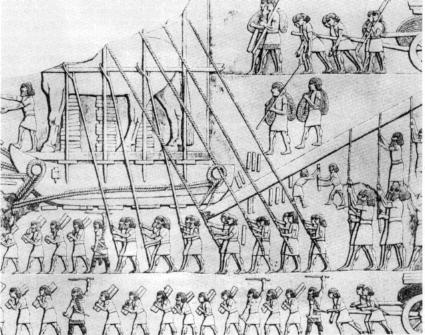 |
Fig. 6.41 A human-headed winged bull for the palace of
Sennacherib
being dragged on a sledge, as depicted on a relief from
his palace at Nineveh. |
One should recall here the famous representations of the transport of
winged bulls from the palace of Sennacherib at Nineveh (about 700 b.c.)
(fig. 6.41),'27 which
show that in Mesopotamia, some 700 years later, exactвХЬly the same transport
methods were used. The Assyrian bulls are lying on huge wooden sledges
(one bull is standing), which are being pulled over short rollers. From
the front, prisoners of war are pulling on four heavy double ropes, to
which they are attached by cords pulled over their shoulвХЬders. From behind,
others are helping with enormous levers, which are pulled down with ropes
by several men at each rope. The levers are set on wedge-shaped fulcrums,
which can be raised with additional wedges. Other men are forced by guards
to carry the rollers from behind the sledge to thefront to be reused there.
The rollers seem to be short pieces that could be put under only one runner
of the sledge and that could not reach from one side to the other.
Since a heavy sledge would gel stuck in sand and dust, it could be hauled
over only solid ground, stone chips, or specially prepared roads. From
the boat glide of Mirgissa, representations of workers pouring out water
in front of sledges, and the experience transmitted by Chevrier,128
we know that a road surface of mud or lime treated with water would considerably
reduce the friction. Chevrier found that six men could easily pull a sledge
loaded with a 4.8-ton stone on a horizontal plane covered with watered
mud. The relation would thus be one man per ton.
The pulling force could be increased by the use of oxen, as it was still
done in the nineteenth century.129
Not only were such animals represented in the early Eighteenth Dynasty
relief just mentioned, but carcasses of four strong bulls that apparently
died from exhaustion during construction work were actually excavated by
H. E. Winlock in the temple of Men-tuhotep at Deir el-Bahari.130
The stone quarried in Roman times in the Mons Claudianus area was apparently
transported with the help of cattle.131
The route stations along the Wadi Qena were equipped with huge stables
that could accommodate 300 to 400 animals. Whether the stones were moved
on sledges or wagons here is unknown.
To what extent animals could be used for pulling sledges is also unвХЬknown.
The examples from the quarries of Carrara show that twenty-eight animals
could be properly arranged and guided. They would easily have had a pulling
force of 150 to 200 tons.132
One can imagine, therefore, lliat a sledge loaded with a weight of 1000
tons would have needed 200 animals.
Compared with the method of using rollers to move monuments, the sledge
has the great advantage of being more easily controlled, especially for
keeping the correct direction of movement. The monument itself is also
much better protected against the impact of ropes, levers, and rollers.
One would assume, therefore, that the transport of heavy and precious monuвХЬments
was carried out on sledges and that rollers were used only for ordiвХЬnary
building material and rough work.
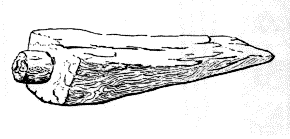 |
Fig. 6.42.Wooden wedge with a handle.
Sixth dynasty from Saqqara(Cairo)
|
Wedges вИЩ An essential tool for every mason who handles
blocks of any size is the wooden wedge. Its main purpose is to keep a block
aloft during work so that hands or a lever can easily be put under the
edge to move the stone. Such wedges must have existed in great numbers
in Egypt, but because they are little valued, few have been noticed in
excavation and even fewer have been published.133
 |
6.43.Wooden hand wedge from the pyramid of
Senwosret I at Lisht. ( MMA acc.no. 34.1.35) |
In order to facilitate the pulling out of the wedge from its position
under a stone, some were made with a handle, carved from the same block
of wood (figs. 6.42, 6.43). The old and still often cited statement that
wooden wedges were inserted into wedge slots in order to break stones with
the help of the swelling power of water was shattered in 1965 by Roeder.134
Metal wedges were not known in Pharaonic Egypt.
Iron wedges for splitting blocks of stone have been found in the Ramesseum.
Petrie dated them to about 800 B.C.,135
but they could be of a much later date as well.
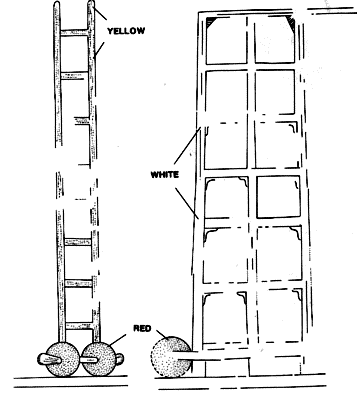 |
Fig. 6.44 Siege towers moved on wheels, as depicted in
the
tomb of Kaemheset at Saqqara and Intef at Qurna, sixth
and
Eleventh Dynasties. |
Wagons вИЩ We assume that wheels and carriages were introduced
into Egypt only in the Second Intermediate Period, when Egypt was involved
with its northeastern neighbors, who possessed horses and chariots. From
then on, chariots became an essential part of the equipment of the EgypвХЬtian
army and were also used as prestigious toys of the nobles of the New Kingdom.
The picture of the Old and Middle Kingdoms without the knowledge of wheels
and carriages is shaken, however, by the discovery of two wall paintings
of the late Old Kingdom and the Eleventh Dynasty depicting siege towers
that were moved on wheels (fig. 6.44).136
It would be strange if transport wheels were restricted to only military
purposes and not used for moving other heavy weights as well.
There are indications that the carriage of the New Kingdom was used
not only for fighting and hunting, but also for transporting goods. In
the tomb of Ahhotep (early Eighteenth Dynasty), a wood and bronze model
of a four-wheeled wagon was found,137
on which funerary barks were deposвХЬited. In the tomb ofSobeknakht at el-Kab
(also early Eighteenth Dynasty), a funerary bark is represented being pulled
by two oxen on what seems to be a four-wheeled carriage (only two wheels
are shown, of course).138
In the funerary papyrus of Maiherperi of a later date in the Eighteenth
Dynasty, a funerary bark on a sledge is being pulled on rollers or wheels.139
Some representations of Late Period date show that four-wheeled carвХЬriages
were frequently used in temple processions for displaying barks and shrines.
Remains of such a wooden temple carriage were excavated in the temple of
Medinet Madi.140 The
only reference to large-scale transport in wagons is from the Ramesside
period, in the report on the expedition of Ramesses IV to the Wadi Hammamat,
which mentions: "There were transвХЬported for them supplies from Egypt in
ten wagons, there being six yokes of oxen to [each] wagon, drawing [them]
from Egypt to the mountain of Bekhen."141
One might suppose, however, that this was not the first expeвХЬdition to
use ox carts. Still, there is no evidence that the ox wagons of Ramesses
IV were also used for the transport of the bekhen stone back to
the Nile Valley. The size of the work force in connection with that expedition
I although the number may be misinterpreted) seems to indicate that workвХЬers
were also used for hauling stones. Carts drawn by oxen may have been used
much later to bring the material from the Mons Claudianus and Mons Porphyrites
down to the Nile Valley—for example, the sixteen columns of tinted granite
for the Pantheon in Rome, each of which was 12.5 meters long and weighed
48 tons.
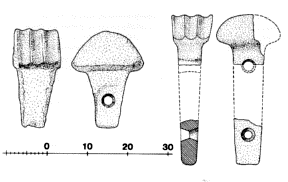 |
Fig. 6.45 Bearing stones of the Fourth Dynasty
found in the pyramid city of Khentkaus (A)
and the valley temple of Mycerinos (B). |
Bearing Stones or Ropes вИЩ At Giza were found two stone
implements, apвХЬparently of Old Kingdom date, that were part of an unknown
device to pull or lower three parallel running ropes over an edge or around
a corner. The first one, of basalt (24 centimeters long, 18 centimeters
wide), was found in the pyramid city of Khentkaus (fig. 6.45).142
Its head has grooves for three thick ropes and was inserted with an elongated
mortise like a bearing into some device—probably not in stone, for it was
fixed with a round peg or tenon. The second one, from the valley temple
of Mycerinus. is of dark slate (37 centimeters long, 16 centimeters wide)
and is broken (fig. 6.45).143
Its mortise is longer and has room for two pegs to be fixed.
By the shape of the head of the stones, one may conclude that they were
made to change the direction of the ropes by 45 to 90 degrees. The object
into which the stones were inserted must have been a pole, the head of
a scaffold, or a kind of trestle.144
The shape of the head and the way it was fixed to a shaft prevent it from
being used for vertical lifting or lowering.
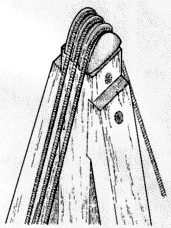 |
Fig. 6.46 Possible use of a
bearing stone to change the
direction of the pull of ropes |
This could have been achieved only by putting it into an oblique shaft
or crane (fig. 6.46). In a vertical position, the weight pulled could have
been moved only at an angle of 45 degrees. It could have well served, therefore,
to lift or lower heavy weights—for example, a pillar or a colossal statue.
We have here a primitive forerunner of a pulley, or a so-called fast
pulley, firmly attached to a shaft. The existence of this device seems
to indicate that real pulleys made of a wheel with a grooved rim did not
yet exist. M. Isler has suggested to me that bearing stones would have
been superior to even wooden pulleys because the wooden pulley axles would
have been too fragile to bear heavy loads.
NOTES
1 Richard Lepsius, Die alt-aegyptische Elle (Berlin, 1865);
W- M. Flinders Petrie, Ancient Weights and Measures (London,
1926), 38-41; Petrie, Kahun, 27; Petrie, Illahun, Kahun and
Gurob 1883-1890 (London, 1891), 14. See also Erik Iversen, Canon
and Proportions in Egyptian Art, 2nd ed., ed. Yoshiaka Shibata (Warminster,
1975), 14-19, pl. 33; A. Schwab-Schlott, MDAIK 28 (1972); 110-111.
2 Ernesto Schiaparelli, La Tomba intatta dell'architetto Cha: Relazione
sui lavori della missione italiana in Egitto, anni 1903-1920 (Turin,
1927), 168-173, figs. 154-156, and 80, fig. 47.
3 BM 6025 = Lepsius no. 14.
4 The nby is mentioned on Theban ostraka (William C. Hayes,
Ostraka and Name Stones from the Tomb of Sen-Mut (No. 71) at Thebes. Publications
of the Metropolitan Museum of Art Egyptian Expedition 15 [New York, 1942],
36). The nby may be identical with the units on two (incomplete)
rods discovered by Petrie at Kahgun (Petrie, Kahun, 27; Petrie,
Illahun, Kahun and Gurob, 14). There is no need, however, to interpret them
as foreign units.
5 L. Borchardt, ZÄS 42 (1905); 70-72; W. Schenkel, in LÄ iv,
115. The cord was called nwh (P. C. Smither, JEA 27 [1941]: 74-76).
6 Reisner, Mycerinus, 78, n. i. For early representations of
the hieroglyph, see Petrie, Royal Tombs I, pls. 9 [1-5], 11 [6,
16], 21 [28], 31 [46]. Generally understood as a "looped cord serving as
hobble for cattle" (Alan Gardiner, Egyptian Grammar [London, 1973],
523 [V 16]).
7 Statues of Senenmut, Penuris, and Amcnemhat-Surer (L. Borchardt,
ZÄS
42 [1905]: 70-72; Jacques Vandier, Manuel d'archeologie egyptienne III,
Plates (Paris, 1958), pl. 164 [1, 3, 6].
8 CEAEM, fig. 62; S. Berger, JEA 20 (1934): 54-56; Norman De
Garis Davies, The Tombs of Mencheperrasomb, Amenmose and Another
(London, 1933), pl. 17; Charles Wilkinson and Marsha Hill, Egyptian
Wall Paintings (New York, 1983), fig. 46.
9 Dorner, "Absteckung," 94-95. See also W. Meyer-Christian, MDAIK
43 (1987) : 197
10 CEAEM, Fig. 265a = MMA 22.3.72; Hayes, Scepter
i, fig. 192 (center).
11 Petrie, Tools and Weapons, 42,
pl. 48 [B64—89].
12 CEAEM, fig. 264; Petrie, Tools and Weapons, 42, pl.
47 [B57] (Cairo 27280).
13 Petrie, Tools and Weapons, 43, pl. 49 [94]; Gautier,
Licht,61, fig. 72 (Cairo 31044); Alexander Badawy, Ancient Egyptian Architectural
Design (Berkeley and Los Angeles, 1965), 40-43.
14 Petrie, Tools and Weapons, pl. 47 [60] (burial of Senedjem,
Nineteenth Dynasty, Cairo 27259). A model from the tomb of Meketra is in
the Metropolitan Museum of Art, New York (MMA 20.3.90, measuring 15.1 ×
11.5 centimeters). For a model from a Twelfth Dynasty tomb at Nag' ed-Deir,
see William K. Simpson, Papyrus Reisner II (Boston, 1965), frontispiece.
See also J. E. Quibell and A. G. K. Hayter, Teti Pyramid, North Side:
Excavations at Saqqara (Cairo, 1927), 41.
15 Rekhmire, pl. 55.
16 Vitruvius, The Ten Books on Architecture VIII.5; see also
Paulys Real-Encyclopädie der classischen Altertumswissenschaft in (Stuttgart,
1899), 2439-2440 (s.v. "Chero-bates").
17 Gunther Binding and Norbert Nussbaum, Der Baubetrieb nördlich
der Alpen in zeitgenössischen Darstellungen (Darmstadt, 1978), 93, 99,
133.
18 WB III, 331/12; WB IV, 86/15, 261/10-13.
19 Petrie, Tools and Weapons, 42, pl. 47 [58, 59] (both in
Cairo 27258). For the discovery, see E. Toda, ASAE 20
(1920): 154.
20 Gautier, Licht, 60, fig. 71 (Cairo 31045, CG 1931).
21 W. M. Flinders Petrie, Amulets (London, 1914), pl. 4.
22 See, in general, CEAEM, 105-106, pl. 2650; D. Stocks, Manchester
Archaeological Bulletin 2 (1987): 42-50.
23 Rekhmire, pl. 62. A model of this scene was displayed in
the Egyptian Museum, Cairo.
24 Krauth, Steinhauerbuch, 186-188, figs. 243-245.
25 Jequier, Pepi II III, 47, fig. 46 (Cairo 52347); CEAEM,
fig. 2650; Petrie, Tools and Weapons, 43, pl. 49 [B44-50]. The set
B from Beni Hasan (Middle Kingdom) is square. Egypt's Golden Age,
no. 27 (New Kingdom [from Deir el-Bahari]).
26 D. Stocks, Manchester Archaeological Bulletin 2 (1987); 49-50,
fig. 25.
27 For metal tools in general and their application, see R. Anthes,
MDAIK 10 (1941): 79-121; W. Barta, in LÄ IV, 19-20. For Minoan Crete,
see Shaw, Minoan Architecture, 44-61, figs. 35-48.
28 R. Michael Cowell, in W. V. Davies, Tools and Weapons, vol.
i,Axes (catalogue of the Egyptian Antiquities in the British Museum) (London,
1987), 96-101, with more references on recent surveys and analyses of Egyptian
metalwork.
29 Ibid., 98; see also Zaki Nour, Cheops Boats, 34—39.
30 Lucas and Harris, AEMI, 235—243.
31 A. R. Williams and K. R. Maxwell-Hyslop, Journal of Archaeological
Science 3 (1976); 283-305. A foreign origin of the tools cannot be
ruled out.
32 See the articles byJ. C. Golvin in ASAE 68 (1982): 165-190;
ASAE 70 (1984-1985):
371-381; and Hommages a Francois Daumas (Montpelier, Vt., 1988), 299-329.
33 Petrie, Royal Tombs n, 24, 28, pls. 6, gA, 38 [94], 41.
34 Petrie, Tools and Weapons, pls. 21, 22. The variety of tools
used by stonemasons of the nineteenth century a.d. is illustrated in Krauth,
Steinhauerbuch,
i 76— 185, figs. 233-242. Eigner seems to have noted the traces of droves
or boasters (4.5 to 7 centimeters wide) and of a 1.1-centimeter-wide toothed
claw with seven claws (necessarily of metal) (Grabbaulen, 84). This
concerns the tomb of Pedineith (Theban Tomb no. 197), which dates, however,
only from the period of Amasis (about 550 b.c.). A true metal hammer in
the Metropolitan Museum of Art, New York (MMA ace. no. 30.8.113), is certainly
too small to be used for stoneworking.
35 CEAEM, fig. 263a, said to be from Gebelein.
36 Rekhmire, pls. 52-55.
37 Henri Wild, Le Tombeau de Ti in (Cairo, 1953), pls. 120-124,
133; Norman De Garis Davies, The Rock Tombs ofDeir el Gebrawi (London, 1902), pl. 16.
38 F. Debono, ASAE 46 (1947); 265-285. Two examples were found at Qurna,
probably dating from the Twenty-second to Twenty-sixth Dynasty (CEAEM,
fig. 266; Petrie, Tools and Weapons, pl. 53). Engelbach believed
in the existence of metal mason's picks (ASAE 29 [1929]: 19-24).
His suggestions are based, however, on traces on a sarcophagus of Persian
or Ptolemaic date (H. Abou-Seif, ASAE 24 [1924]: 91-96).
39 R. Klemm is convinced, however, that the tool marks in quarry walls
were not produced by picks but by pointed chisels (personal communication).
40 Firth an Quibell, Step Pyramid, 128, pl. 93 [7].
41 Engelbach, Aswan Obelisk, 11-13.
42 Henri Wild, Le Tombeau de Ti II (Cairo, 1953), pls. 97, 129.
43 Junker, Giza X, 16.
44 Engelbach, Aswan Ohflisk, pl. 4 [2]; Reisner, Mycerinus,
236-237, pls. 20a-c.
45 Wild, Tombeau de Ti II, pls. 97A, 129.
46 For representations, see Gustave Jequier, Les Frises d'objets
des sarcophages du Muye'n Empire (Cairo, 1921), 279.
47 M. Isler, JEA 73 (1987): 137-147.
48 J.-P. Lauer and F. Debono, ASAE 50 (1950): 1-18.
49 Possibly some of the specimens in Petrie, Kahun, pl. 16;
Petrie, Illhun, Kahun and Gurob, pl. 7. One example from Giza
(Zaki Nour, Cheops Boats, pl. i5A).
50 Petrie mentions flints in the builder's debris thrown over the cliffs
of Giza; he does not consider them to be tools, but thinks that they originated
from clearing the desert surface (Pyramids and Temples, a 13). Large
numbers of flakes broken from stone tools have been found, however, in
the stonecutters' debris around the pyramid of Senwosret I at Lisht (unpublished
data). They are enclosed in layers of granite dust. B. Vachala and J. Sroboda observed large quantities of hammerstones
and flint tools around limestone buildings at Abusir ZÄS 116 [1989]:
178) and suggest the use of stone tools for dressing limestone.
51 Krauth, Steinhauerbuch, 180, fig. 238.
52 Petrie, Tools and Weapons, 40, pl. 46; CEAEM, fig.
264; De Morgan, Dahchour n, 105, fig. 153; Egypt's Golden Age,
no. 25; Arnold and Winlock, Mentuhotep, 60-61, pls. 34b, 35a-b.
53 Emery, Great Tombs n, fig. 69, pi- 30; W. M. Flinders Petrie,
Deshasheh
(London, 1897), pl. 34.
54 Edouard Naville, The Xlth Dynasty Temple at Deir el-Bahari ill
(London, 1913), 18. For more examples of mallets, see ibid., pl. 29 [3].
55 See, in general, CEAEM, 194, 202-204; Lucas and Harris, AEMI, 42-44,
66-71, 423-426; Petrie, Pyramids and Temples, 173; Holscher, Chephren,
77-79; Borchardt, Neuserre, 142-143; Zuber, "Travail des pierres dures," 205-215;
D. Stocks, Popular Archaeology (April 1986): 24—29; Jequier, Frises d'objets
sarcophages du May en Empire, 275-277.
56 Ali El-Khouly, Egyptian Stone Vessels of Predynastic Period to Dynasty
III (Mainz, 1978).
57 D. Stocks, Popular Archaeology (April 1986): 24-29.
58 Shaw, Minoan Architecture, 69—70, figs. 61-63.
59 L. Gorelick and A. J. Gwinnett, Expedition (1983): 40-47. Their
result contraвХЬdicts Stocks's experiments, which seem to have achieved striations
on stone cores with dry quartz sand. Stocks also notes that A. Lucas found
a mass of quartz sand in a drill hole of an alabaster fragment (Popular
Archaeology [April 1986]: 24-29).
60 Lucas and Harris doubt that emery was found in Egypt and suggest
its being imported from the Greek Islands. G. Schweinfurth seems to have
located a findspot near Aswan; however, see Borchardt, Neuserre, 142. Pliny
mentions that for sawing stone, sand had to be imported to Rome from India,
Egypt, and Nubia (Natural History xxxvi. 9-10).
61 Petrie, Pyramids and Temples, 176.
62 Numerous examples are in the Djoser complex (Firth and Quibell,
Step Pyramid, pls. 64 [i], 86 [6], 93 [i]; C. M. Firth, ASAE 25 [1925]:
pl. 5 [2]). For a later example, with 36-centimeter-deep drill holes in
granite slabs, see Ricke, Sonnenheiligtum I, fig. 9.
63 Junker, Giza in, 190, fig. 34.
64 D. Stocks, Popular Archaeology (April 1986); z6, fig. on p. 28.
Apparently, the sarcophagi of Sekhemkhet (Lauer, Hist. Mon. i, 195) and
of Cheops (Petrie, Pyramids and Temples, 176) were drilled that way. How
common the method was, however, is not established.
65 Firth and Quibell, Step Pyramid, pl. 94 [5]; Holscher, Chephren,
77-79; Borchardt, Neuserre, 142, tig. 122 [i]; Petrie, Pyramids and Temples,
173. Holscher mentions, without further details, "the end of a bronze drill
which had broken off deep in the boring" (Mortuary Temple n, 37). Tiny
bronze fragments can also be seen in the drill hole in a doorpost of Ramesses
II in the Metropolitan Museum of Art (ace. no. 13.183.2).
66 Firth and Quibell, Step Pyramid, pls. 86 [6], 93 [1-2]. Petrie cites
a slightly later example, which he explains as a "pivot block to turn heavy
blocks on in moving stone" (Meydum and Memphis, 5, pl. 20).
67 See, in general, CEAEM, 203—204; Junker, Giia x, 82; Jequier, Frises
d'objets des sarcophages du Moyen Empire, 271—273; Zuber, "Travail des
pierres dures," 202-205.
68 Lauer, Hist. Mon. I, 253.
69 Zuber, "Travail des pierres dures," 202-205.
70 Lauer, Hist. Mon. I, 195, 235; Anna Maria Donadoni-Roveri, / Sarcofagi
Egizi dalle origini alia fine dell'antico regno (Rome, 1969), A1.
71 Borchardt, Re-Heiligtum, 44.
72 Petrie, Tools and Weapons, pl. 52 [53]; Petrie, Pyramids and Temples,
174.
73 Donadoni-Roveri, Sarcofagi Egizi dalle origini alia fine dell'antico
regno, B10 and B31; from the tomb of Djedefhor (Cairo CG 6193) and from
mastaba Giza G 7270 (Kunsthistorisches Museum, Vienna), see Junker, Giza
x, 82.
74 Petrie, Tools and Weapons, pl. 52 [57].
75 Ibid., pl. 52 [52, 54, 56].
76 Borchardt, Re-Heiligtum, 44> gives only "Abusir."
77 Reisner, Mycerinus, 116.
78 D. Stocks, Popular Archaeology (April 1986): 28-29.
79 One example of iron from the seventh century b.c. could be of foreign
origin (A. R. Williams and K. R. Maxwell-Hyslop, Journal of Archaeological
Science 3 [1976]: 383-305). Numerous Minoan saws are preserved, the largest being 1.7
meters long and 21 centimeters wide (Shaw, Minoan Architecture, 55-69,
figs. 43-46). Most of them have teeth along the entire length of their
cutting edges. The mason's saws were toothless, however. They have small
round holes in one end. These holes were intended for the attachment of
wooden handles. Saw marks are recorded on hard limestone, conglomerate,
green schist, and speckled basalt. The width of saw cuts ranges from 1
to 2 millimeters. Frequently, saw cuts were used only as a "guide line"
in order to produce a clean break when the stone was struck with a hammer.
80 Garstang, Bet Khallaf, pl. 23 [35].
81 Vitruvius (Ten Books on Architecture n. 7.1) and Pliny (Natural
History xxxvi. 9-10) mention cutting stone with toothless saws. For modern
usage, see Marble, 136-142, figs. 157-169. The author's remarks on ancient
Egypt are completely misleading, however.
82 Lucas and Harris, AEMI, 134-136; Ryan and Hansen, Cordage.
83 Carefully studied from representations of rope-making scenes by
E. Teeter, JEA 73 (1987): 71-77.
84 Zaki Nour, Cheops Boats, 42, pls. 12, 63-65.
85 E. A. M. Greiss, BIE 31 (1949): 271-272. Apparently, six ropes were
found, one of which was 56 meters long.
86 Zaki Nour, Cheops Boats, pl. 38.
87 Ryan and Hansen, Cordage.
88 J. J. Janssen, Commodity Prices from the Ramessid Period (Leiden,
1975), 439; Janssen, Two Ancient Ship's Logs (Leiden, 1961), 87.
89 Engelbach, Aswan Obelisk, 25.
90 B. Catoire, in Karnak VII, 181-202.
91 Rekhmire, pl. 58.
92 G. Daressy, ASAE I (1900): 28.
93 J. D. S. Pendlebury, The City of Akhenaten III (London, 1951), 45,
pl. 74 [1]. Is the 52-centimeter-long copper instrument depicted in CEAEM,
fig. 263a, a crowbar or a long chisel?
94 For late examples, see Winlock, Hibis, pl. 48.
95 Lacau and Chevrier, Hatshepsout I, 9, fig. I.
96 For example, the casing blocks of the Cheops Pyramid and core blocks
of the mortuary temple of Chephren. See also Zaki Nour, Cheops Boats, pl. 32.
97 On core blocks of the mortuary temple of Chephren. Good examples
are in Holscher, Chephren, pl. 8. Reisner observed up to five mortises
along the lower edges of the core blocks of the mortuary temple of Mycerinus,
10 to 15 x 20 to 30 centimeters wide and 10 to 15 centimeters deep (Mycerinus,
75).
98 Holscher, Chephren, pl. 17.
99 Karnak V, 79-82, Figs. 2, 3, pl. 31.
100 Ibid., 163, fig. 3.
101 Golvin and Goyon, Karnak, 130. The application of huge levers pulled
down with ropes is also shown in the reliefs of Sennacherib at Nineveh
(Julian Reade, Assyrian Sculpture [Cambridge, Mass., 1983], figs. 51, 51).
102 Petrie, Pyramids and Temples, 212. It is not certain, however,
that the relieving chambers were already planned when the blocks could be loaded on one of the lower courses in order to "travel" upward.
103 Many have been found. A photograph at the Metropolitan Museum of
Art, New York, shows thirty-six rockers from foundation deposits of Hatshepsut
excavated by Edouard Naville (E. Naville, The Temple of Deir el Bahari
VI [London, 1908], pl. 168; Hayes, Scepter II, 85-86, fig. 47; Ägyptens
Aufstieg zur Weltmacht, no. 69a).
104 For example, Choisy, L'Art de batir, 80-86; Borchardt, Re-Heiligtum,
62; J. Fitchen, Journal of the Society of Architectural Historians
37 (1978): 3-9.
105 CEAEM, 102-103, figs. 107-109.
106 Petrie, Tools and Weapons, 41 [B37],
107 On the road to the Inca fortress Ollantaytambo, building blocks
still lie along the roadside, one on rollers of adder wood (J. Ogden Outwater,
in Tecnologia Andina [Lima, 1978], 581-589, fig. 3). At Nuri (Sudan),
two short thick granite rollers were found in Pyramid VIII (Engelbach,
Aswan Obelisk, 38).
108
CEAEM, fig. 267, from the pyramid of Pepy II (=Jequier, Pepi II,
III 47-48, fig. 44, in Cairo 51432); Petrie, Tools and Weapons, pl.
49 [B38, 39]; Guy Brunton, Lahun I (London, 1920), pl. 20A; MMA
24.1.77 and [24.1.78] (unpublished).
109 De Morgan, Dahchour II, 90, fig. 134; E. Chassinat, Fouilles
de Qattah, MIFAO 14 (Cairo, 1906), 22, fig. 8; Gautier, Licht,
figs. 77, 78, 90; Arthur Mace and Herbert E. Winlock, The Tomb of Senebtisi
at Lisht (New York, 1916), 14, figs. 5, 6. Burial pit of vizier Mentuhotep
at Lisht with a network of short poles (60 to 80 centimeters) in front
of the sarcophagus. Poles for rolling roofing slabs (Arnold, Qasr el-Sagha,
fig. 9, pl. 7C). Poles for sliding coffin lid in position (Maragioglio,
Piramidi VIII, pl. 10).
110 Arnold, Amenemhet III I, 22, pl. 44b; Jequier, Deux pyramides,
pls. 8, 17; Maragioglio, Piramidi v, pl. 8 [4, 6]; Gautier, Licht,
72, fig. 90; queen's pyramid 3 of Senwosret I at Lisht (unpublished data);
P. Montet, ASAE 46 (1947); pl. 79, with a granite plug on four rollers
blocking the crypt of King Psusennes at Tanis.
111 N. Charlton, JEA 64 (1978); 128. From observations made in the quarries
of Carrara, one would expect instead crossbeams for transportation on such
uneven ground (Mannoni, Marble, fig. 245).
112 Saleh and Sourouzian, Kairo, no. 142a (Eighteenth Dynasty
papyrus of Maiherperi).
113 Rekhmire, pl. 58.
114 G. Goyon, Revue Archeologique 2 (1963); 5, n. i.
115 Mannoni, Marble, figs. 129-132, 248, 256.
116 As it was certainly done in Mesopotamia. Compare the representations
of the transport of winged bulls on sledges (with rollers!) from the palace
of Sennacherib (Reade, Assyrian Sculpture, figs. 50, 51).
117 De Morgan, Dahchour i, 83, fig. 204; CEAEM, fig.
85; George A. Reisner, Models of Ships and Boats (Cairo, 1913),
88-89.
118 BMMA 15 (July 1920); 10-11, fig. 7 (MMA no. 24.1.84);
Hayes, Scepter I, fig. 118.
119 A similar sledge from the tomb of Tutankhamun symbolically carried
the gilded Ka shrine of the king.
120 W. M. Flinders Petrie, Seventy Years in Archaeology (London,
n.d.), 100. The present location of the sledge is unknown.
121 H. G. Fischer, JEA 67 (1981); 166, fig. 1. Many examples are in
Marianne Eaton-Krauss, The Representations of Statuary in Private Tombs
of the Old Kingdom (Wiesbaden, 1984).
122 G. Goyon, BIFAO 69 (1971): 11-41, pls. 3-5; H. G. Fischer, JEA
61 (1975): 33-34. fig. 2.
123 Percy E. Newberry, Bersheh i (London, 1895), pl. 15; J.
Vandier, CdE 18 (1943): 185-190; A, Badawy, MIO 8 (1963):
325-332. Model made by R. Engelbach in 1933 (H. Chevrier, RdE 22
[1970]: 22-23, pl. 1).
124 Vyse, Pyramids in, 99, no. 6; G. Daressy, ASAE 11
(1911): 263-265; Saleh and Sourouzian, Kairo, no. 119.
125 Naville, Temple of Deir el Bahari VI, pl. 154.
126 Rekhmire, 55, pl. 58.
127 Austen Henry Layard, The Monuments of Nineveh II (London,
1849), pls. 13-17; Archibald Paterson, Assyrian Sculptures: Palace
of Sennacherib (Haarlem, 1915), pls. 110-123. Mulloy suggests that
the Easter Island statues were moved on one-piece sledges made of tree
forks ("Easter Islands," 9-12). They would have been moved forward with
the help of a bipod seated above the sledge.
128 H. Chevrier, RdE 22 (1970): 20.
129 Mannoni, Marble, figs. 129, 134-137, 245, 248. For the role
of oxen in medieval church building, see lan Dunlop, The Cathedrals'
Crusade (London and New York, 1982), 52.
130 Arnold and Winlock, Mentuhotep, 62, pl. 37.
131 J. Roeder, MDAIK 18 (1962); 89-91.
132 Mannoni shows a block weighing about 40 to 50 tons pulled by fourteen
oxen (Marble, fig. 129).
133 Jequier, Pepi II III, 47, fig. 45, and CEAEM, fig.
267 (Sixth Dynasty, Cairo 51433); Hayes, Scepter I, 290, fig. 192
(MMA 34.1.35, made of hard tamarisk wood).
134 J. Roeder, Archaeälogischer Anzeiger 3 (1965): 467-551.
135 Petrie, Tools and Weapons, 41 [B16-17], pl. 13.
136 Quibell and Hayter, Teti Pyramid, North Side, frontispiece;
H. Senk, ASAE 57 (1954): 207-211; Brigitte Jaros-Deckert, Das Grab des
Jnj-jtj.f: Die Wandmalereien der XI. Dynastie (Mainz, 1984), foldout
3.
137 Saleh and Sourouzian, Kairo no. 123. For another example
from the NineвХЬteenth Dynasty, see Guy Brunton and Reginald Engelbach, Gurob
(London, 1927), pl.52.
138 N. De Garis Davies, JAE 12 (1926): 111.
139 Saleh and Sourouzian, Kairo, no. 142a.
140 K. H. Dittmann, MDAIK 10 (1941): 60-78.
141 Jules Couyat and Pierre Montet, Les Inscriptions hieroglyphiques
et hieratiques du Ouadi Hammamat (Cairo, 1912), 38, lines 19-21.
142 Selim Hassan, Excavations at Giza IV, 1932-9333 (Cairo,
1943), 44 [23], pls. 18A-B.
143 Reisner, Mycerinus, 272, pl. A [6].
144 A relief from the tomb of Apui at Saqqara might suggest that the
bearing stones could also have been inserted into the tops of masts of
sailing boats (CEAEM, fig. 45).

















































